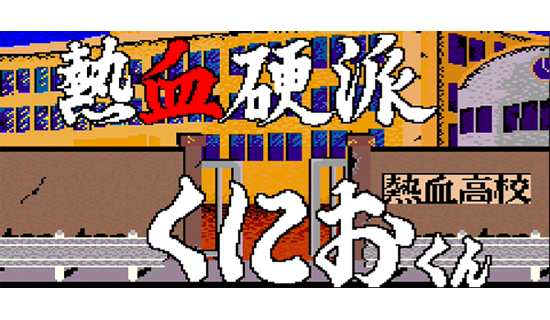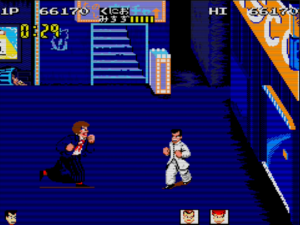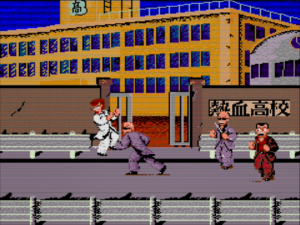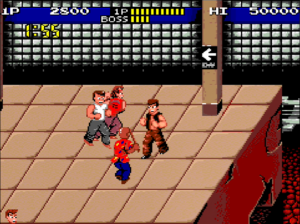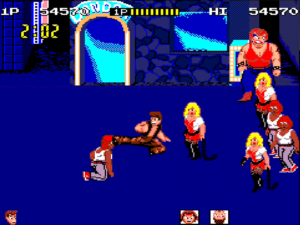Delinquent high school students talking tough and beating each other up in school uniforms while sporting distinct hair styles is probably not unfamiliar to those who enjoy Japanese media. This genre, called “tsuppari” (or “yankii”/”yankee” as we got into the 90s), was very prevalent in from the 1970s through the 1990s. Technos Japan’s Nekketsu Kouha Kunio kun (“Hot Blooded Tough Guy Kunio”) was the video game front runner for this genre, proceeding even one of the most well known representations of tsuppari, a manga series called “Crows”. It’s unclear how much inspiration was actually taken from other media, but in a 2013 interview director Yoshihisa Kishimoto said that the game reflected his own high school experience.
Technos Japan was formed in 1981 by three former Data East employees. Initially operating out of a single-room apartment, They had been developing arcade games since 1982 but had not yet had a major success. 1986’s Nekketsu Kouha Kunio kun would be that first major success, propelling them to not only make a ton of spin-offs and sequels, but also many other revolutionary titles in the side-scrolling beat-em-up genre.
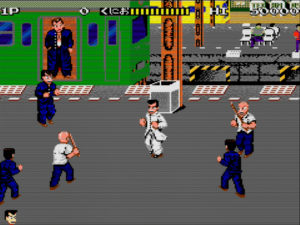
Kishimoto was not a founding member of Technos Japan, but he did come from Data East. There he worked on arcade games, primarily of the interactive laser disc variety such as Thunder Storm/Cobra Command and Road Blaster/Road Avenger. Kunio was his first project with Technos Japan, so he’s considered to be the father of the Kunio kun series despite only going on to direct a couple more titles in it. That’s likely because he was too busy moving the beat-em-genre forward with titles known the world over, such as Double Dragon (which he would remain a bit closer to as time went on). He stayed with Technos Japan well into the ’90s, but eventually parted ways with them to go freelance as a producer/consultant for not only browser and mobile games, but also many budget titles on the PlayStation and PlayStation 2. In 2010 he founded his own company called “Plophet” (named after a pseudonym he used for some of his production work), where he would continue on with similar projects.
Nekketsu Kouha Kunio kun is the story of Kunio (whose name came from Technos Japan President Taki Kunio, whereas the full title was a parody of the 1984 Konami title Shinnyuu Shain Tooru kun (New Employee Tooru)) challenging various groups of thugs and misfits after they attack his best friend Hiroshi (potentially the only student at this school that actually studies, since the manual mentions him as a good student). In the arcade version, Hiroshi’s abduction is actually shown at the beginning of each stage, with him even getting knifed during the final stage intro. Each of the four stages is cleared by simply beating all of the enemies in it, including the boss, within the time limit. Life is managed by an energy bar for both Kunio and the boss character, and the default number of lives is only one (though a setting that can be used to extend it to one extra life) with extra lives being earn-able based on score (though that’s not easy). The arcade version features only a single semi-scrolling screen per stage, with the boss looking on from the background until you take out a few of his or her underlings.
The sound design of Kunio is unique not only for its fun rockabilly soundtrack, but also also for the voice samples contained in the arcade version (a rarity at the time). A female voice stoically cheers you on with “ganbatte ne” (“Give it your best”) when you insert a coin, and the various boss characters taunt you when you’re down. Kunio was released in American arcades by Taito under the name Renegade (it would also be ported to the NES under the same name), retaining the same game play but changing up all of the character sprites to be more in line with typical American action movie tropes. The voice samples were even re-recorded in English for the arcade version.
The side-scrolling beat-em-up genre did not yet have a rich history. Its arcade/home console grand father was Irem’s Spartan X/Kung-Fu Master/Kung Fu, with mostly games bearing the Hokuto no Ken/Fist of the North Star license that carried on the torch on consoles (borrowing heavily from Spartan X in terms of game play). The typical pattern was punch/kick each using a separate button, and jumping/crouching using the stick or pad. This worked well since all of these games were scrolling in one direction on a single plane, so the character was unable to move up or down. Kunio was the first beat-em-up to introduce the idea of being able to move your character in all directions within a single screen.
Because your character can now move up and down though, jumping has to be done with a button. In this case, that means a jumping attack requires A and B to be pressed simultaneously. Though enemies can crouch to avoid this, it’s a necessary technique to master since it’s by far the most effective way to beat most enemies (Yes, this was the beginning of the long running beat-em-up tradition of the jump kick being your ticket through the entire game!). While that idea isn’t very hard to get used to, Technos Japan had unfortunately not yet figured out the best way to handle attacking in the same direction that you were moving your character. This results in the left and right directions being strictly for movement and positioning of the character, with an attack button for each front and back attacks instead of punch and kick. If you attack in the direction your character is facing, out comes a chain-able punch. The opposite direction results in a kick which has a slightly longer range. You can also combine those with directional inputs to grab and punch, throw, or get on top of enemies to damage them even more. Though this control scheme would be changed to a more intuitive one with Technos Japan’s next beat-em-up, we haven’t quite seen the last of it. It’s typically the reason that most don’t bother playing very far in, but it doesn’t take very much practice to get down.
While today Nekketsu Kouha Kunio kun/Renegade is mostly just a historical piece that is an originator of a once thriving genre that now and again rises to popularity, its importance at the time can’t be overstated. It was the next major evolution in beat-em-ups, even though it ultimately didn’t end up the best remembered of the bunch. Most will be perfectly happy with playing one of its descendants instead, whether they be in the Kunio kun series or just in the genre itself. Things will get nothing but better for both!
There are so many different ways to play Nekketsu Kouha Kunio kun and/or Renegade that it’s ridiculous. This arcade version appears in the form of the 2006 Hamster port to PlayStation 2 under the “oretachi Geesen zoku” series (released in Japan only, and also features a soundtrack CD and DVD featuring game-play footage packed in), and its far more accessible port to the Playstation 4 as a part of the Arcade Archives (also by Hamster) series in 2014 (both Kunio kun and Renegade are available separately, at least on the Japanese PlayStation store). It also made a late Wii Virtual Console appearance in 2012 courtesy of D4 Enterprise. Cellphone and Windows ports also exist.
